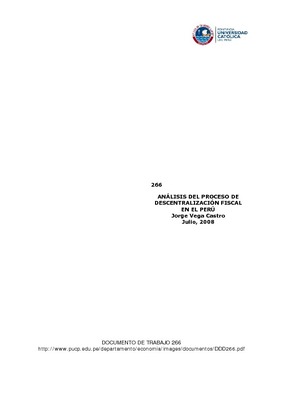| dc.contributor.author | Vega Castro, Jorge | |
| dc.date.accessioned | 2015-03-19T20:37:47Z | |
| dc.date.available | 2015-03-19T20:37:47Z | |
| dc.date.issued | 2008 | |
| dc.identifier.uri | http://repositorio.pucp.edu.pe/index/handle/123456789/46906 | |
| dc.description.abstract | En el Perú se está implementando un profundo proceso de descentralización política y económica, iniciado con claridad en el año 2002. A los dos niveles de gobierno que tradicionalmente existían en el país, como son el gobierno nacional y los gobiernos locales, se ha sumado un nuevo nivel intermedio: el de los gobiernos regionales. Llevar adelante este proceso ha requerido una notable transformación de la administración fiscal del país. El gobierno nacional ha transferido importante funciones y recursos fiscales a los gobiernos regionales a la vez que ha reforzado ostensiblemente los ingresos de los gobiernos municipales. Ambos gobiernos subnacionales han duplicado sus presupuestos en solo cinco años. Sin embargo, éstos se financian principalmente con transferencias del gobierno nacional y no tanto con recursos tributarios propios, recaudados por ellos. En este estudio se analiza el régimen económico-fiscal de ambos gobiernos subnacionales y se ofrecen recomendaciones para potenciar la economía de estas instituciones, buscando de hacerlas menos dependientes del financiamiento del poder central. | es_ES |
| dc.description.abstract | Peru is experiencing a deep political and fiscal decentralization process, especially since 2002. The newly created regional governments now share power and resources with the existing municipal governments as well as with the national or central government. The national government has transferred important responsibilities and fiscal resources to regional governments and also has reinforced local governments’ budgets. Both levels of subnational governments have doubled their budget revenues in only five years. However, they are mostly financed by national government transfers instead of own collected taxes. This study analyzes in detail the functions as well as the fiscal resources of subnational governments in Peru. Based on this analysis, a set of proposals to increase direct income sources for both levels of government are discussed. | en_US |
| dc.language.iso | spa | es_ES |
| dc.publisher | Pontificia Universidad Católica del Perú. Departamento de Economía | es_ES |
| dc.relation.ispartofseries | Documento de Trabajo;266 | es_ES |
| dc.rights | info:eu-repo/semantics/openAccess | es_ES |
| dc.rights.uri | http://creativecommons.org/licenses/by-nc-nd/2.5/pe/ | * |
| dc.subject | Descentralización fiscal--Perú | es_ES |
| dc.subject | Política fiscal--Perú | es_ES |
| dc.title | Análisis del proceso de descentralización fiscal en el Perú | es_ES |
| dc.title.alternative | An analysis of fiscal decentralization in Peru. | en_US |
| dc.type | info:eu-repo/semantics/workingPaper | |
| dc.type.other | Documento de trabajo | |
| dc.subject.ocde | http://purl.org/pe-repo/ocde/ford#5.02.00 | |
| dc.publisher.country | PE | |


